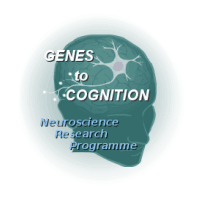An Integrative Neuroscience Program Linking Mouse Genes to Cognition and Disease
Seth G. N. Grant
(Taken from Behavioural Genetics in the Post Genomic Era, Edited by Robert Plomin, John C Defries, Ian W Craig and Peter McGuffin, American Psychological Association 2002. ISBN 1-55798-926-5) PDF version
- Introduction
- General Strategy & Outline
- Connecting the Molecular Mechanisms of Learning
- A Multilayer Organisation
- Layer 1: Identification of Genes Encoding Assemblies
- Layer 2: Genomics
- Layer 3: Functional Genomics - Experimental Neuroscience
- Layer 4: Informatics
- Structural Issues for a Large Multidisciplinary Program
- Conclusions
General Strategy and Outline of G2C
A key feature of this strategy is the linking of mouse and human genetics. Genes involved with learning can be discovered in mice (1361685; 7512771; 1321493). Because of the homology between mice and humans at the levels of the gene, the protein, the synapse, the brain region, and the behaviour, there is a high probability that a gene involved with learning in a mouse will also be important in humans. This notion has been substantially supported by many studies.
An alternative approach to finding the genes involved with learning, or other behaviors, is to score for variation in the phenotype between individuals and then seek the genetic differences that correlate with these changes. This approach has been widely used and particularly successfully for finding large-effect genes underpinning some disorders (e.g., Huntington's disease).
Gene-targeting technology and the use of embryonic stem (ES) cells allow the experimentalist to modify the structure of any given gene or chromosome in the mouse in a controlled manner (9853825). The widespread use of this technology has led to many hundreds of mouse genes being disrupted or modified. These mutant mice are routinely examined in a wide variety of assays, many of which are aimed at exploring the dysfunction of the nervous system. In this way, lists of genes are being developed in which the named genes are known to be required for the normal physiological function in question. These lists can be used to design experiments in humans, in which one asks, Does the behavioral abnormality in humans correspond to an altered structure of the corresponding human gene? To illustrate how this might work, let us consider the molecular mechanisms of learning as revealed by studies in the mouse and ask if this is informative for studies in humans. First, I provide a brief overview of the history of the molecular biology of learning.
